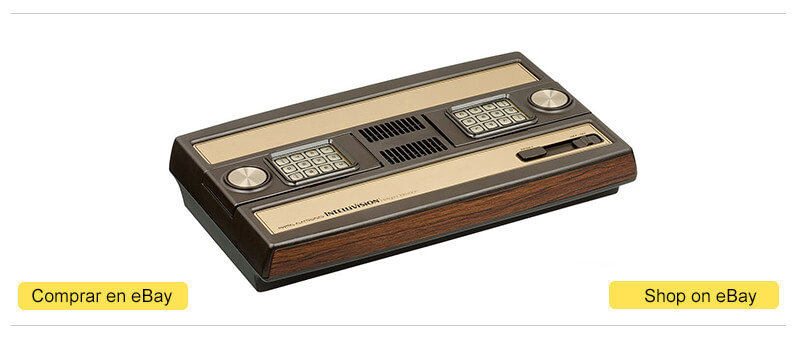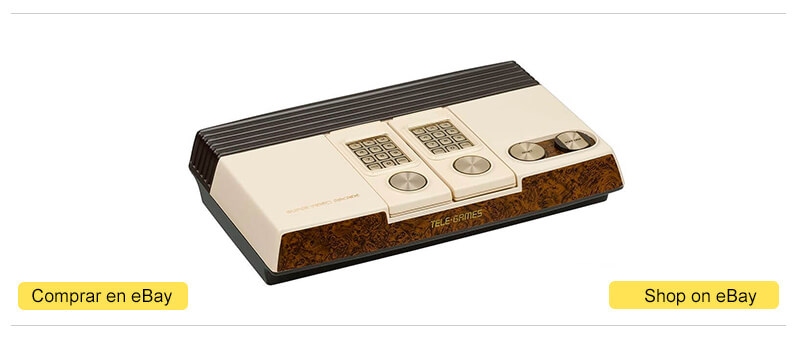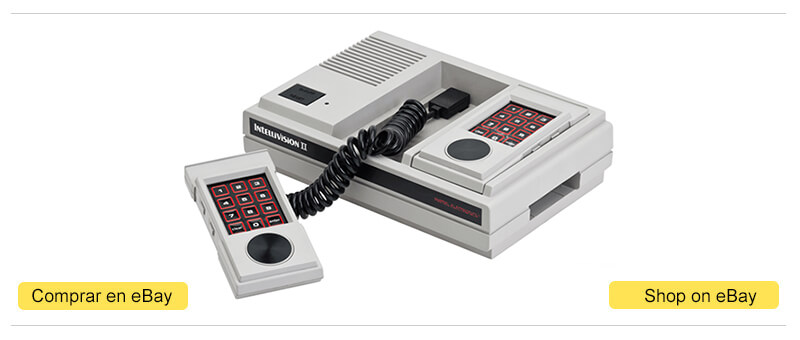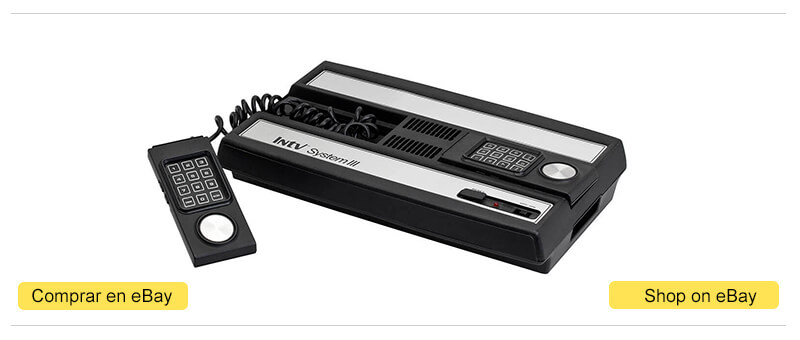Intellivision is an exciting console, a 16-bit machine launched in 1979, on which its creator, Mattel Electronics, created a whole universe with a single objective: to conquer the video game market and crush its most direct rival, the Atari 2600.
To achieve its goal, the giant Mattel created the most powerful console of its time, a second-generation technological beast that, the same year as the premiere of «Apocalypse Now», promised: Modem, cable game, keyboard module, BASIC programming , synthesizer, printer… And video games, also video games.
| COMPANY: | MATTEL ELECTRONICS |
| CONSOLE GENERATION: | 2ND GENERATION OF CONSOLES |
| RELEASE DATE: | 1979 in the United States 1982 in France 1982 in Japan |
| GAMES CATALOGUE: | 132 games until 1989 |
| SOLD UNITS: | 4 million worldwide |
| LAUNCH PRICE: | $275 in the United States |
| PROCESSOR: | CPU General Instrument CP1610 16-bit at 2 MHz |
| FORMAT: | Cartridge and cassette (with peripheral) |
| BUY IT ON EBAY: | https://ebay.us/C12VgP |
- History of Intellivision.
- Intellivision modules.
- Intellivision models.
- Intellivision console price. How much?
- Collect Mattel’s Intellivision.
- Buy a second-hand Intellivision.
- TOP Retro: Best Intellivision games.
- FAQ Intellivision.
- Intellivision technical characteristics.
Intellivision, the first 16-bit console
Welcome to the 70’s! The crazy years of the first and second generations of consoles, the decade of the birth of video games, their boom in arcades and their transition to the domestic market, the time of excessive evolution of systems, innovations, failures and successes.
The 70’s marked the way forward in the video game industry, an explosion of hundreds of companies joining a new and lucrative market by contributing their innovations to their respective new systems. Evolution, the market and capitalism would do the rest.
Although the first generation of consoles was characterized by hundreds of Pong-type systems with similar characteristics produced around the world, the second generation came hand in hand with programmable ROM cartridges and the consolidation of the Atari Empire, a company that knew how to monopolize arcade video games. and domestic thanks to its Atari 2600 console.
Launched the Atari 2600 in 1977, in years that seemed technologically eternal and hardware leaps happened month after month, its success was immediate and its business model (cartridges) was definitively validated from the beginning. The Atari 2600 became the benchmark to beat for an entire industry.
Mattle comes into play
Since 1976, the toy giant Mattel, thanks to its new brand, Mattel Electronics, had entered the video game market with its handheld Mattel’s Auto Race, the first of a large line of portable machines.
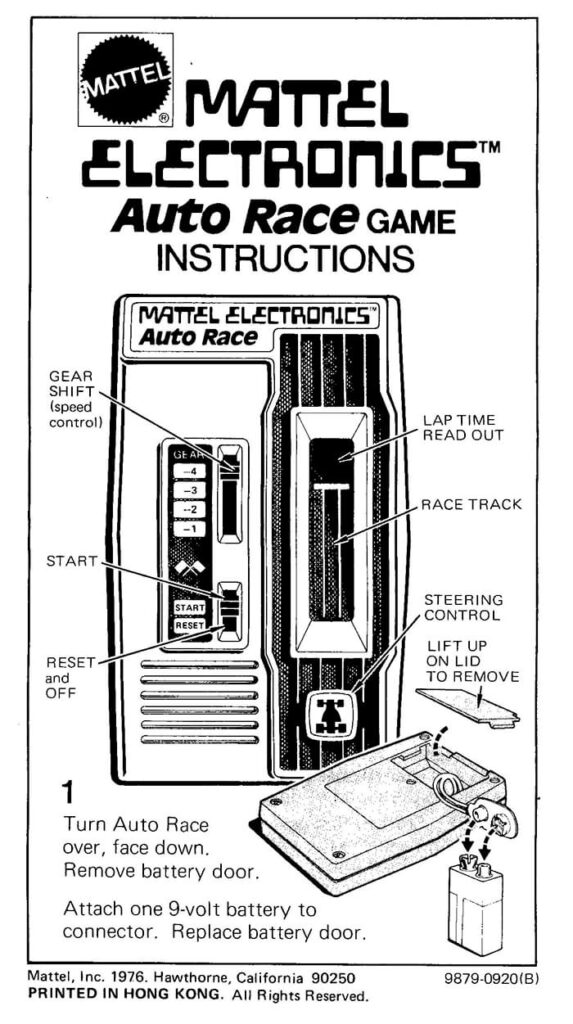
In 1977, along with its line of portable machines on the market, Mattel began to develop in California what would be its desktop console. Its machine had to be clearly a differentiated and superior product to the present, with the Atari 2600 being its rival to beat. .
Mattel Electronics chose as a basis a new programmable chipset from General Instrument called Gimini, to which they requested a series of changes that were ready in August 1978. Deciding on the chipset, David Chandler of Mattel began designing the hardware while David Rolfe of the consultancy APh Technological Consulting, was in charge of the internal software of the console (EXEC).
THE INITIAL CONCEPT OF THE INTELLIVISION January 1979, the Intellivision is announced and presented at the CES in Las Vegas as a modular computer that could be purchased in two parts: 1st - Master Component: The master component, the console and its controls, the essentials to play, were announced with a retail price of US$165. 2nd - Keyboard Component: The keyboard module with built-in cassette and hardware improvements, with which we converted our video game console into a brand new computer, for another US$165. This commercial strategy facilitated the first purchase of the console under the promise of becoming a future computer, but also committed Mattel to launching the keyboard/computer expansion module as it was an advertising promise. On the other hand, it represented a clear competitive advantage over the Atari console. This marketing method based on dividing a single system into two was very popular in the late 70's and until the mid 80's, put into practice by well-known companies such as Nintendo and its Famicom or Sega and its SG-1000. , both released in 1983. At the end of the 70's, personal computers were still considered a luxury product, so giving the user the possibility of buying a computer in 2 installments, enjoying a video game console from the beginning, made all the sense in the world. . On the other hand, the concept of "computer by deadlines" was a brilliant argument to convince those parents who considered that video game consoles were child's play and a waste of time (a thought that microcomputers just established).
At CES in Chicago held in June of the same year (1979), Mattel Electronics was already forced to review the prices of the Intellivision console (the master component) and the keyboard expansion, going from US$165 to US$165. $250 each item.
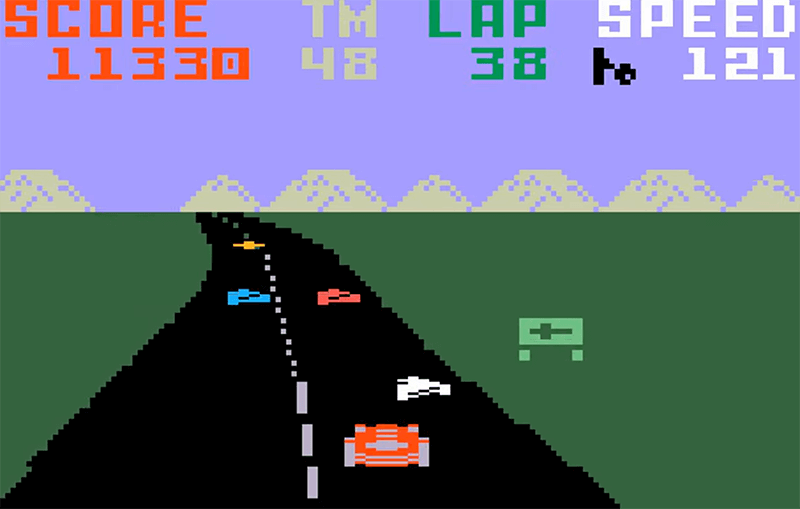
The launch
Thus, we find ourselves in the middle of 1979 with the Intellivision console already finished, but with a serious problem in its production line, General Instrument could not provide the necessary number of chips (a very typical problem in production lines that make use of new technologies), so there were few Intellivision units that could be made available to the public in those months.
And that is when the dance of the manufacture and distribution of the Intellivision begins. As we have already mentioned, in the 70’s the pioneers hardly had references to follow when it came to innovating, and with regard to the distribution of systems, the companies were not aware of the importance of brand image and loyalty. of users, so they prioritized placing the largest number of systems in stores… even if their brand was nowhere to be seen.
To be fair, we must say that the distribution channels and the logistics of production and distribution of video game consoles and personal computers were in their infancy, which is why old formulas were used, new paths were explored and not yet arrived at the current distribution models, in which retailers are practically at the mercy of the big companies (much the same as non-retailers).
In this context, Mattel contracted the American manufacturer of electronic components Sylvania, to manufacture and sell the Intellivision under its own brand, with its own logistics network and in its GTE Corporation stores (Philadelphia, Baltimore and Washington, DC). Intellivision hit the market in the fall of 1979 as the GTE Sylvania Intellivision Console.
The contract with Sylvania served Mattel Electronics as a market test and later, Mattel placed its console under its own brand «Mattel Electronics» in different chains such as Gottschalks and JCPenney, while other more powerful businesses and chains such as SEARS or Radio Shack launched your own custom Intellivision:
- The SEARS Super Video Arcade, which we’ll look at below, was the same console but with a distinctly different exterior design. This commercial action was a blow to Atari, since Sears stores previously had their own versions of their consoles using Atari hardware, from the days of Atari Pong and its SEARS TELE-GAMES PONG.
- Radio Shack’s Tandyvision One was the exact same console with some custom logos (Mattel and Intellivision disappeared) and darker wood trim.
By 1980, Intellivision was already in stores all over the United States with the recommended price of $275, it had become a popular console and in 1981 its sales already exceeded one million units. For the first time, Atari had a worthy rival that was endangering its reign in the domestic market.
In 1982, Mattel’s 16-bit console reached most of the potential markets of the time, from Spain and Europe to Japan, varying the method of distribution (licenses) depending on the date and country… Anyone want a Bandai Intellivision?
Mattel’s commercial strategy and its Intellivision was very aggressive against Atari, its console was much higher than the Atari 2600, so once it was launched, its advertising was based on comparing the features of both consoles, supported by the credibility of characters and famous athletes, as can be seen in the following television ad:
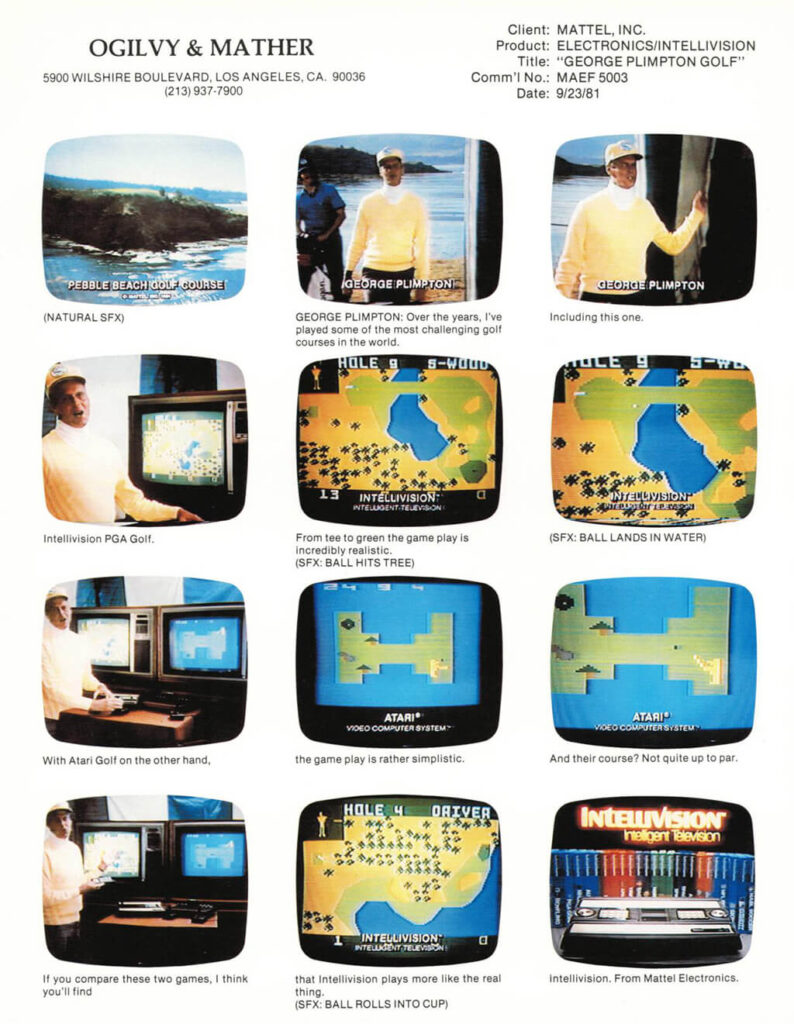
As a defense against the new consoles and systems that were appearing since 1977, the Atari 2600 obviously promoted its strengths:
- It was the best-selling console in the history of video games, the most popular with more than 30 million units sold in its commercial life.
- His video game catalog was huge, everything was on the 2600.
- It was cheaper than superior systems like the Intellivision.
The Blue Sky Rangers While the first 19 Intellivision games were programmed by outside company APh Technological Consulting, in 1980 Mattel hired its own team of programmers to develop games on its Intellivision. The rivalry with Atari was so great and the figure of the programmer was so in demand, that so that its employees were not recruited by other companies such as Atari, Mattel kept secret the identity, place of residence and work of this exclusive group of programmers, the which were known as the Blue Sky Rangers.
Intellivision, the console and its controls
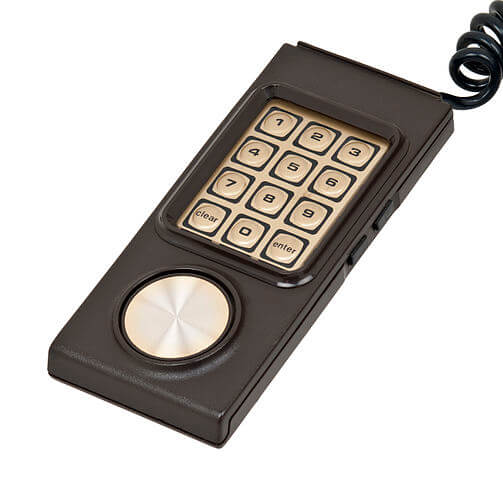
With a clear aesthetic designed to fit in the huge living rooms of well-to-do North American families, highlighting the wood laminate to match the TV cabinet, the Intellivisión was at its launch the most powerful console in the world, which is not bit…
With considerable dimensions even for that time, the Mattel console moved away from the already insufferable Pong-style video games of the first generation, offering much more developed video games thanks to its features and the chosen format: The ROM cartridge.
Although the last stage of the first generation of video game consoles was characterized by having the games in memory, thanks to the proliferation of the General Instruments AY-3-8500 chip and its variants, the second generation of consoles came innovating with its cartridges. Programmable ROMs, a brutal leap that allowed users to discover new worlds while bringing the arcade software industry closer to the home market.
Intellivision joined the new generation of consoles, bringing arcade hits and new exclusive experiences to our living rooms, with never-before-seen graphics. And how were these dozens of games and new genres played? With its characteristic command, hallmark of the Mattel console.
Intellivision was never conceived as a video game console, but as «Smart TV» and the central part of a home computer. Therefore, from the beginning their games were deeper in approach than the competition, they were more complex and more realistic, so a simple joystick with an action button was not enough for their ambitions.
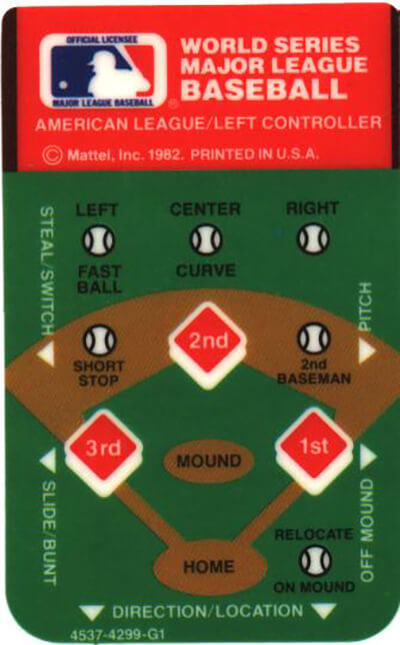
Intellivision's characteristic square controller has 12 front buttons (0-9, CLEAR and ENTER), plus four side buttons (two and two). Unlike joysticks of the time, Mattel opted for a 16-way pad. To facilitate the game and improve immersion, the video games included a sheet that was superimposed on the controller, thus being personalized and giving meaning to the 12 buttons. The result? A failure, at least from an ergonomic point of view. It is true that the controller with the overlays offered new gameplay and control possibilities adapted to each game, but its rectangular shape and its corners, together with the unnatural way of holding the controller and playing with both hands, negatively affected the playability of a console that had everything to win... except the controls. Surprisingly, the controls of the Intellivision were copied in 1982 by the Colecovision and the Atari 5200, nothing to say...
On the other hand, the initial concept of the Intellivision, being sold and advertised as part of a computer, caused a flood of surprising peripherals for today’s gamers, as we will see in its corresponding section a little below.
The gaming experience today
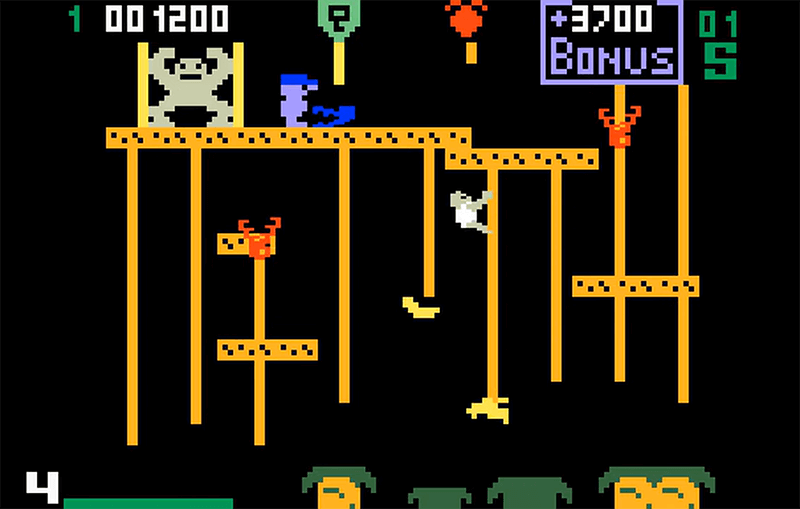
As we have already mentioned, the Intellivision controls made the playability of many of its games difficult, at a time when, no matter how deep they were, most of them were based on direct action mechanics (spaceships, sports games…) .
But of course, that was in the late 70’s and early 80’s, years in which players gladly accepted everything. For our current refined tastes… have you tried playing with an original Game Boy without an IPS screen? Well, that, the controls of the Intellivision for later generations destroy the entire Intellivision catalog with a stroke of the pen.
And it’s a pity, because within the Intellivision catalog, we find games that are very advanced for their time, but we are not going to fool ourselves… Players who do not enjoy the second generation at the time are not prepared for their games , we can play for a while, yes, but in no case a significant game session.
One moment! Are you one of those who went to the Star Wars premiere at the cinema with your friends? Were you already smoking when the Soviet Union invaded Afghanistan? Then you are in luck, you have the wonderful factor of nostalgia, in fact, surely your nostalgia is not direct, but indirect, a nostalgia for the console that you wanted and never had, because you already had an Atari 2600, but it is nostalgia after all and at the end
Be that as it may, if nostalgia is on your side things change, hundreds of memories will make their way into your mind as you enjoy again a second-generation console, memories of mom’s dining room and walls covered with embossed wallpaper, with its round ashtrays and fluorescent green crystal glasses…
You will take the controls, you will introduce the game and… You will verify that time has not passed in vain and that the second generation of consoles has aged fatally, it is a pity but it is reality. Unless you lost your virginity playing Q*bert, there is no nostalgic memory that saves this generation (including the rest of the consoles).
In my particular case, something similar happens to me with the ZX Spectrum, I have pure love and devotion for it… until I start playing and discover again that my patience and capacity for wonder is no longer what it was. A real pity…
And even so! After all this, within the Intellivision catalog we will find a series of extremely deep and elaborate games for their time, well above the competition, authentic wonders. They are realistic and strategic video games in which, before playing, it was essential to have studied the manual and have the overlay for the controller. Here’s a perfect example: B-17 Bomber, using the Intellivoice, is worth a look.

Let no one be mistaken, as collectors and retro lovers, at Infoconsolas we value and enjoy 1st and 2nd generation consoles, we are very aware of their historical importance and the evolution they entailed... But as regards the current gameplay, reality is what it is.
The death of Intellivision

When the Intellivision was released, most potential households already had a 2nd generation console for a year or two at most: The Atari 2600.
While reaching a crowded market is already difficult (tell SEGA), doing it when families had shelled out a lot of money a few months earlier is an impossible task. Even so, the Intellivision was such a superior console that it managed to enter the video game market and consolidate itself as a real alternative year after year… Until the arrival of the Crash of 83′:
In 1983, video game consoles were going through their worst moment, dozens of first and second generation systems dominated a market in which its highest reference, the Atari 2600, disappointed its users due to the poor quality of its video game catalog.
On the other hand, the cheap microcomputers had taken off as a successful product, since they were sold as educational, professional, leisure tools and an essential element to learn the profession of the future in the 80’s: Programming. In addition, the price of its format, the cassette tapes, was infinitely cheaper than the cartridges.
Faced with a large financial outlay, the parents of the time were clear about it, rather than a video game console that «only served to play children’s games and waste time» (mentality of the time), they would buy a Commodore 64 computer, ZX Spectrum or Amstrad, systems that also, graphically and were superior to the consoles of the time (prior to 1983).
The result was the commercial death of most existing video game consoles or, in the best of cases, for a few, the residual adaptation to the new situation in which microcomputers were the new kings of home video games, sharing space with the new third generation super consoles (NES and Master System).
Fortunately for the history of Intellivision and being a sample of its capabilities and technical features, the console remained commercially alive until 1990 under the INTV Corporation brand and its INTV System III, a company that bought the rights to the console from Mattel in 1984 and He kept it alive by releasing his own version until 1990, quite an achievement if we think that these are the years of the reign of Nintendo and Sega.
Intellivision expansions and modules
The initial concept of Intellivision caused it to have a series of expansions and peripherals that today seem to have come from the future, being undoubtedly one of the strengths of this console. Mattel created for Intellivision a whole universe of peripherals that transformed its console into the definitive second generation system.
In turn, this is a sample of how immature the video game market and industry was still in the late 70’s and early 80’s. Without a defined course, the Intellivision attacked all fronts, creating new paths and trends that would become benchmarks to follow, or would fail miserably. Let’s get to know them:
PlayCable | 1981

PlayCable was the video game download service developed by General Instrument and Mattel for their Intellivision console. Playcable worked through cable television, being necessary to purchase the corresponding module and pay the cost of the monthly payment.
Each month, the PlayCable service offered 15 games (later it became 20) for subscribers, who chose the game they wanted to play and it was downloaded to the memory of the 8K RAM module. The download period of the games ranged between 10 and 20 seconds.
Since General Instrument is the manufacturer of the Intellivision chipset, the Mattel console was the first option to benefit from this service from the outset, being considered the first video game download service in history, which is no small thing… .
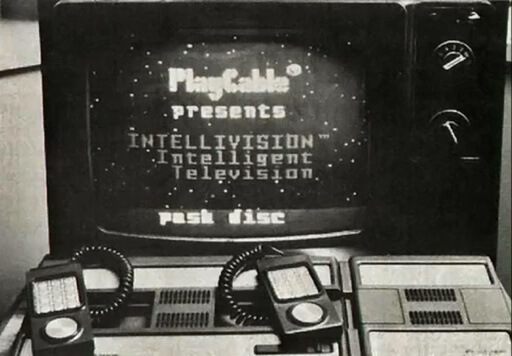
Commercially, it was proposed as a way to replace cartridges, making comparisons of the game on cartridge and downloaded in its advertisements, in which it was evidently shown that the final result was the same. PlayCable was a real breakthrough in the video game industry, but its service ceased in 1984 for different reasons:
- The module’s RAM was too low for the most powerful games on the console (with more memory), so they could not be integrated into the catalog.
- The game catalog did not include third parties, it was Mattel’s own, so when Mattel ceased commercial production of Intellivision in 1984, the service suffered a major blow.
- The service had an approximate monthly cost of $12 (depending on the operator) while that of the cartridges was $25, a price that proved to be high based on the number of subscribers (a subscription rate of less than 3%). To put ourselves in the situation, let’s think that consoles like the Xbox One have had similar service at the same price decades later.
- For cable television providers, implementing this service and reserving the necessary channels involved a very high cost, which is why it was not standardized.
- The Crash of 1983 also affected this service.
Exposed the information, let's hallucinate a little: 37 years before the arrival of Microsoft's Game Pass (2017) for its Xbox consoles, Mattel provided its 16-bit console with a monthly video game download service... INCREDIBLE. We are talking about a concept that has been fully developed at the dawn of 2020, with Internet technology fully established and consolidated. Offering the same concept of distribution, almost 40 years earlier under a technology as limited as that of cable television, is simply impressive and one more example of how alone these video game pioneers were... They were the ones who created the paths through which the rest of the coming companies traveled, trial and error proof.
Keyboard Component Module | 1981
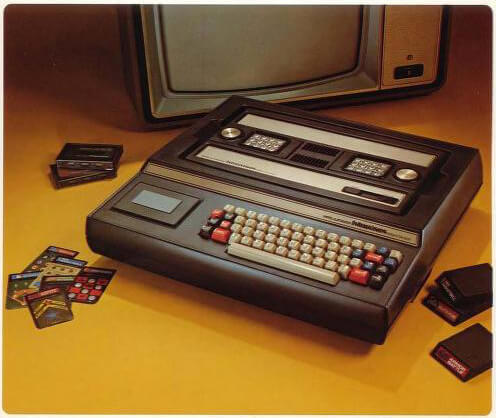
From the outset, Mattel advertised its video game console as part of a whole, a modular personal computer sold in parts, something very logical given the high price of this type of technology in those years. Consequently, the idea and motivation of many Intellivision users was to expand their system to convert it into a computer, thanks to which you could also access the new VIDEOTEX service…
VIDEOTEX was a new technological revolution from which the Intellivision and its keyboard component could benefit. Very similar to the popular teletext of the 90's, which had a one-way data flow, with our televisions being mere receivers, Videotex offered an improvement in a two-way data flow, so in practice we could, in addition to checking the weather, buy stocks or plane flights. The difference with the Internet? In a very summarized way, while the Internet was characterized years later by having a network of networks made up of thousands and thousands of servers, Videotex had a main server where all the information was stored.
The Keyboard Component module was a very ambitious and risky bet for the time, including the following technical improvements within the keyboard itself:
- 8-bit 6502 CPU
- 16K × 10-bit SRAM,
- 40 × 24 text overlay
- Tape drive
- Microphone input
- 2 expansion ports and extra RAM.
- 1 cartridge entry.
Added to the features of the Intellivision, we had a computer with two processors and some very interesting features for the time. On the other hand, the tape format provided much more capacity than ROM cartridges at a cheaper cost.
The Keyboard Component had its own controller software specialized in multimedia, called PicSe, which was capable of synchronizing the analog audio of the tapes with the system’s own graphics, providing a competitive advantage over the software developed in BASIC, which does not could use these features.
With these characteristics, Mattel engineers had a very difficult time lowering the production costs of a module that had been announced months before for US$250. Mattel was involved in a continuous process of announcements, market tests, delays and new announcements, much to the outrage of Intellivision users.
In the last quarter of 1981, Mattel launched the Keyboard Component under a painful distribution (4,000 units), only two North American cities had physical units and mail order was offered to users who had previously complained. The price? $600, which is pretty crazy considering it was advertised for $250 before it was sold.
The outrage of users led to Mattel being denounced for deceptive advertising and fraud, being fined and forced to indemnify and buy back from users all hardware sold related to the Keyboard Component. Mattel abandoned the Keyboard Component in August 1982, Keyboard Component had been a complete failure with only a few programs for sale, leaving Mattel Electronics’ image badly tarnished.
Several decades later, for collectors of retro consoles and computers, the Keyboard Component has become the holy grail of the second generation, one of the most difficult parts to find and therefore one of the most sought after.
If you want to buy a Keyboard Component module (extremely rare), you can try your luck on the following eBay links with different search terms: - Keyboard Component | View on eBay - Intellivision Keyboard | View on eBay - Intellivision Computer | View on eBay
Intellivoice | 1982
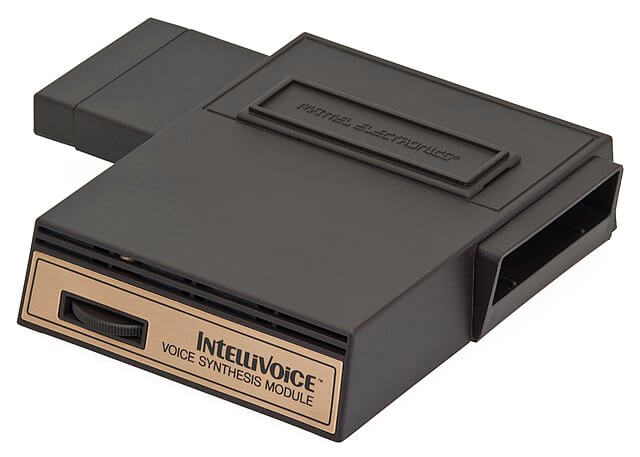
Nowadays, hearing a voice in a video game doesn’t surprise anyone, but in 1982 this voice synthesis module seemed to come from the future, giving our Intellivision the ability to literally speak in their games with male or female voices.
Yes, I know, it’s hard to be surprised if you haven’t lived through that era or you’re a veteran collector, but the Intellivoice offered what no other console of the time could, while maintaining the cartridge format and low memory.
There were four video games that made specific use of this peripheral: Space Spartans, B-17 Bomber, Bomb Squad and Tron: Solar Sailer. If you have not seen it already, we recommend that you watch the video exposed a few paragraphs above of the B-17 Bomber to hear the voices perfectly audible and integrated into the game. Witchcraft.
Cartridges compatible with the Intellivoice were sold under the «It talks!» and «VOICE SYNTHESIS CARTRIDGE», differentiating them in this way from the rest of the console’s cartridges.
If you want to buy a (common) Intellivoice module, you can try your luck on the following eBay links with different search terms: - Intellivoice | View on eBay - Intellivision Voice | View on eBay
System Changer | 1983
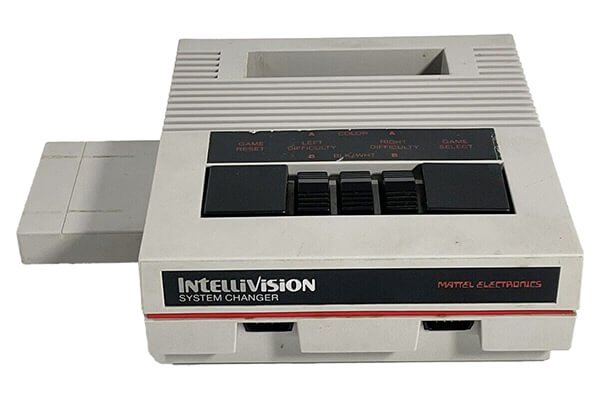
Even though Intellivision was technically much superior, the Atari 2600 had a much larger catalogue, being one of the most important factors when deciding to purchase a new console. Mattel’s solution to this problem was wonderful: Let’s make a module with which we can play Atari 2600 video games on our console… Impressive.
Designed for the Intellivision II, based on Mattel’s System Changer, the Intellivision was announced thanks to this module as the console with the largest catalog of games, since it had its own and that of the competition, the Atari 2600 could no longer use the advantage of its immense catalog of games never again, unbeatable.
Mattel did not complicate life with emulations, inside the System Changer we find a clone Atari 2600, a console in itself that is limited to using the main console as a power source and RF modulator, from what we can affirm that this product is one of the most aggressive marketing maneuvers we have seen in the history of video games.
Since it was designed for the Intellivision II, to connect it to the original Intellivision certain hardware modifications had to be made, a modification that Mattel offered as a service. Regarding the controllers, the Intellivision controllers were compatible, as we can see in the image, the System Changer has 2 inputs for the Atari 2600 joysticks. Everything was perfect.
And the legal aspects? Mattel’s lawyers bet big… And they won. The System Changer as a peripheral did not infringe any copyrighted software, thus making Atari’s legal action against Mattel very difficult.
If you want to buy the System Changer module, you can try your luck in the following eBay links: - System Changer | View on eBay
Entertainment Computer System | ECS Computer Module | 1983
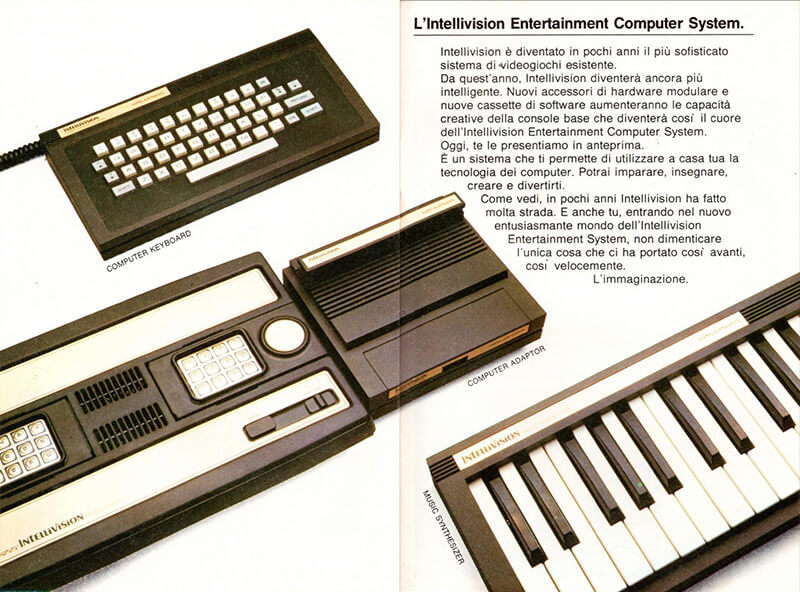
As we have seen before, the Keyboard Component was an absolute failure: Mattel had missed the release dates, the price of the product and the distribution had been disastrous, ceasing production in August 1982. Consequently, many users who had purchased the Intellivision Hoping to expand it to a computer, they felt disappointed and deceived.
Due to these bad practices, Mattel had been fined by the Federal Trade Commission since mid-1982, to pay a large monthly amount until it fulfilled its launch advertising promise: Launch an expansion module that would turn the Intellivision into a computer, distributed correctly.
In 1981, not even Mattel itself trusted that the team of responsible engineers would be able to launch the Keyboard Component module in an acceptable way in time and price, so the LUCKY: Low User-Cost Keyboard project began to be secretly developed. Interface.
That is, a much more basic and cheaper module that fulfilled the initial promise of converting the Intellivision into a computer. While the ambitious Keyboard Component module accumulated failures and disappointments, the Lucky project moved forward, becoming the expansion Entertainment Computer System (ECS Computer Module). Mattel's idea in the development phase was that the ECS would have a retail cost of US$150 maximum, a very competitive price.
The Entertainment Computer System was a much less ambitious project, so its production cost and technical characteristics were lowered:
The internal PicSe software was gone and a version of BASIC was incorporated, it featured 2K of SRAM (instead of 16K), 1 memory expansion port (instead of two), an external tape drive much simpler than the Keyboard Component and the improvement of an AY-3-8917 sound chip, which together with the music synthesizer keyboard (optional), turned the Intellivision into an instrument for playing or learning music.
The result complied with what was promised, the Intellivision user could convert his console into a computer, with which he could program his programs in BASIC (learn computing), record them on a tape and execute them later, while theoretically, he would qualify for a exclusive software catalog and could connect a printer. For Mattel, the ECS Computer Module would lead to an end to monthly Federal Trade Commission fines.
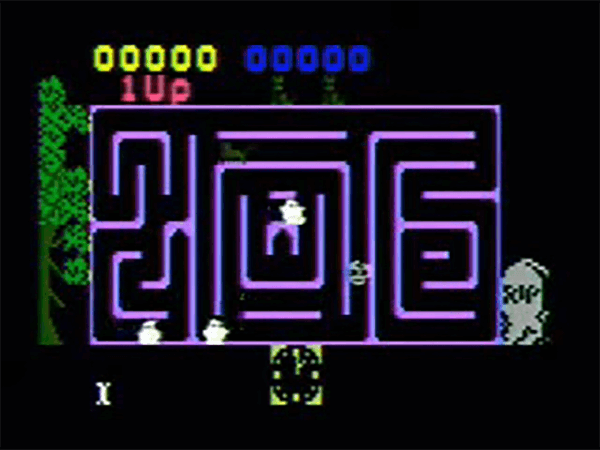
In early 1983, with the Keyboard Component already discontinued, Mattel Electronics released the Entertainment Computer System for a price of US$189.99 (approximate), 6 games were released for this system:
- Jetsons’ Ways with Words
- Mind Strike
- Scooby Doo’s Maze Chase (the top image)
- World Series Major League Baseball
- Mr. Basic Meets Bits ‘N Bytes
- Melody Blaster
Commercial failure? Of course, this peripheral was launched in the middle of the ’83 Crash and a year later Mattel Electronics stopped commercially supporting its own system, licensing it to third parties with a vision restricted to video games (ignoring the ECS). Furthermore, no matter how cheap it was, its market was limited to Intellivision owners, a market that was too small.
The concept of a modular computer was repeated in the video game industry throughout the 1980s, without any system successfully exploiting this combo. In the end, video games always prevailed over the concept of the computer.
Many years later, in 1998, a company was ahead of its time again and launched a console capable of browsing the Internet with an inexpensive keyboard and mouse, once again uniting the worlds of consoles and PCs… The company was SEGA and the Dreamcast console, you already know the rest of the story
If you want to buy an Entertainment Computer System | ECS (very rare), you can try your luck on the following eBay links with different search terms: - Entertainment Computer System | View on eBay - ECS Computer Module | View on eBay
Intellivision models
The distribution system of the 70’s based on licenses, direct contracts with commercial chains and manufacturers of electronic components, multiplied by export agreements with companies from the receiving countries, in many cases protectionist states, causes the majority of consoles of the time have dozens of different versions, which are only usually differentiated from the original by superficial changes or directly in branding and packaging.
The Intellivision was not exempt from this practice and also underwent many versions that only differed in the name or brand, but within this dance of variations and consoles compatible with the original unit, four past and present models stand out above the rest:
Super Video Arcade | SEARS | 1980
In the 1970s, the North American store chain SEARS had such negotiating capacity and was so highly valued that, from the Atari Pong, Atari itself launched its consoles under the SEARS TELE-GAMES brand, such as condition to be sold in their establishments.
In the following years, other companies joined this imposition and launched their consoles under the SEARS TELE-GAMES brand, including Mattel: In 1980 the new Sears console hit the market, the Super Video Arcade, the Sears Intellivision.
Super Video Arcade was exactly the same Intellivision console as Mattel’s, but with two significant changes:
- A superficial cosmetic design change.
- The improvement of removable controls, a real success.
With the Super Video Arcade, Mattel managed to be present in practically the entire North American territory, while at the same time competing directly with Atari under the Sears brand, presenting itself as a more evolved console on the same shelves of the chain of stores.
Intellivision II | Mattel | 1983
In the 80’s, economical versions of the most successful consoles were already launched, and that is what the Intellivision II is, launched in March 1983), a revision of the original, cheaper and smaller console, with one of the designs most beautiful in relation to their time that we have seen in the history of video games.
This practice is very common in successful consoles that have a long enough commercial life: NES II, Master System II, Snes Jr, Game Boy Pocket, PS One, slim versions… Virtually all the consoles that have had Significant sales have received a system overhaul thanks to the cheaper original technology (RAM, CPU…).
In the case of Intellivision II, having the same features, the differences with the first Intellivision are the following:
- Cheaper to produce.
- Lower price, US$150.
- Smaller dimensions.
- Notable aesthetic improvement, in line with the Entertainment Computer System (ECS).
- Removable controls.
- Compatible with System Changer without any modification.
- Worse quality controls: The side buttons became hard plastic and the central buttons no longer had the bubble effect, being completely smooth, so players could no longer feel the buttons and were forced to look at the controller.
As in the rest of the systems that are reviewed, the Intellivision II served to update its console aesthetically before new consoles that had been launched in 1982 (Colecovision, Vectrex…), lower production costs, lower the final sale price and theoretically extend the commercial life of the console.
In practice, Intellivision had a very difficult time, since it suffered stiff competition from more advanced and cheaper machines, plus the Crash of 83′, even lowering its price the same year it was released, from US$150 to US$69 the same year. year of its release.
INTV SYSTEM III – SUPER PRO SYSTEM | INTV Corporation | 1985
The Crash of 83′ was fatal for the video game industry, a meteorite that crashed in a market full of machines and supply, surviving only the systems most adapted to what the market demanded, one of the most critical moments in history. of video games.
Intellivision already had serious problems in 1982 with the launch of new consoles that took advantage of cheaper components and RAM memories, technology advanced and the new systems had better features and cheaper prices (Colecovision, Atari 5200, C64, ZX Spectrum. ..). Added to the Crash of 83′, the cocktail was explosive… And it exploded.
In 1983, the losses of Mattel Electronics were in the millions, causing changes in managers, dismissals of personnel, cessation of hardware manufacturing and finally, the sale of the license and the entire Intellivision business for 20 million US dollars… And here the INTV System III emerges.
Intellivision Inc., the company that had been created to carry on the Intellivision business by a former Mattel Electronics executive and investors, was renamed INTV Corporation in 1984. Having acquired all of Mattel’s stock, the new company continued to supply the product to the retail market and to produce new cartridges under its brand name at a lower manufacturing cost (lower quality).
Once the stock of the Intellivision II had run out, in 1985 INTV Corporation presented its new console to the market, the INTV SYSTEM III also called SUPER PRO SYSTEM, exactly the same original Intellivision but with a change of exterior colors. Simple.
Surprisingly, INTV Corporation also took care to provide its console with new own and third-party games thanks to an association with DATA EAST, ensuring that the system had a commercial life until 1990, launching its last video game in 1989, Spiker! Super Pro Volleyball. INTV SYSTEM III enjoyed 21 new releases in the post-Mattel Era.
INTV Corporation extended the life of the Intellivision, through the INTV SYSTEM III until 1990, the year in which it competed with consoles such as the Famicom, Master System or Megadrive, not to mention computers and PCs. There are few consoles that can boast of having had such a long life, also overcoming the crisis of ’83.
Thanks to INTV Corporation, the Intellivision system coexisted with 4 generations of video games:
- It was born at the end of the first generation, completely surpassing them in performance.
- For years, it was the most powerful console of the second generation.
- It survived the fabulous third generation of Nintendo and Sega.
- It died commercially with the consolidation of the fourth generation of consoles.
The history of the Intellivision system is simply incredible thanks to consoles like the INTV SYSTEM III, from 1984 to 1990 it remained on the market as an anomaly, a second generation console that fought against the NES and the Master System, refusing to die, a vestige American technology company that saw its market becoming smaller and smaller in the face of the Japanese console era.
This wonderful story, this epic story ended in 1990, when INTV Corporation made the leap to develop games for the third generation of consoles, so due to permission and license problems, INTV Corporation had to opt to abandon its own system in order to launch games on Nintendo and Sega consoles.
In 1990, INTV Corporation filed for bankruptcy, closing for good in 1991. End of story.
Intellivision Flashback | AtGames Digital Media, Inc. | 2014
End of story? No! Thanks to the fashion for retro consoles and video games and thanks to the infinite nostalgia that those of us who enjoyed those wonderful years have, in 2014 Intellivision was born again by AtGames.
The Intellivision Flashback is the already typical relaunch of a successful retro console, based on emulation. Maintaining the original aesthetics and controls with their respective overlaps («overlays»), the main unit has a very small size and 60 own games inside. Ideal for the nostalgic and curious.
If we are not purists of the original retro, for a small price, we will be able to play with one of the most iconic consoles of the second generation and experience its characteristic controls, with the advantage of having current connections to our modern televisions.
The games that it carries inside are the following:
- Armor Battle.
- Astrosmash.
- Auto Racing.
- B-17 Bomber.
- Backgammon.
- Blowout.
- Body Slam: Super Pro Wrestling.
- Bomb Squad.
- Bowling.
- Boxing.
- Brickout.
- Buzz Bombers.
- Checkers.
- Chess.
- Chip Shot: Super Pro Golf.
- Crown Of Kings.
- Deep Pockets: Super Pro Pool & Billiards.
- Frog Bog.
- Golf.
- Hard Hat.
- Horse Racing.
- Hover Force.
- Las Vegas Poker & Blackjack.
- Las Vegas Roulette.
- Learning Fun.
- Learning Fun II.
- Math Fun.
- Minotaur.
- Motocross.
- Night Stalker.
- Pinball.
- Royal Dealer.
- Sea Battle.
- Shark! Shark!.
- Slam Dunk: Super Pro Basketball.
- Slap Shot: Super Pro Hockey.
- Sharp Shot.
- Snafu.
- Soccer.
- Space Armada.
- Space Battle.
- Space Cadet.
- Space Hawk.
- Space Spartans.
- Spiker: Super Pro Volleyball.
- Stadium Mud Buggies.
- Star Strike.
- Sub Hunt.
- Super Pro Decathlon.
- Super Pro Football.
- Takeover.
- Tennis.
- Thin Ice.
- Thunder Castle.
- Tower Of Doom.
- Triple Action.
- Utopia.
- Vectron.
- Word Fun.
- World Championship Baseball.
As I said, a magnificent machine with a very representative catalog of the system, to remember or discover old times. Unfortunately, we have not currently been able to find units for sale in the most popular stores, so we understand that its distribution has been discontinued and we will have to search the second-hand market to purchase an Intellivision Flashback.
The price of the Intellivision console
Below, you can see the launch price of the Intellivision I and II along with the rest of the contemporary consoles, focusing on the beginning of the first generation and its most direct second generation rivals:
| CONSOLE | LAUNCH | PRICE | COMPANY |
| Magnavox Odyssey | 1972 | US$99.9 | Magnavox |
| Tele-Games Pong | 1975 | US$98.95 | Atari |
| Atari Pong IV | 1976 | US$98.95 | Atari |
| APF TV Fun | 1976 | US$125 | APF |
| Coleco Telstar | 1976 | US$50 | Coleco |
| Fairchild Channel F | 1976 | US$169 | Fairchild Semiconductor |
| RCA Studio II | 1977 | US$149 | RCA |
| Atari 2600 | 1977 | US$199 | Atari |
| Bally Astrocade | 1978 | US$299 | Bally Manufacturing |
| Magnavox Odyssey 2 | 1978 | US$179 | Magnavox Philips |
| Intellivision | 1979 | US$275 | Mattel Electronics |
| ColecoVision | 1982 | US$170 | Coleco |
| Intellivision II | 1983 | US$150 | Mattel Electronics |
The second generation of consoles began with the Fairchild Channel F in 1976, so when the Intellivision entered a market crowded with cheaper consoles, it had to show why it cost $275, priced only below the Bally Astrocade.
We have to take into account that US$275 from 1979 is the equivalent of US$1,140 in 2022, so in no case can we say that the Intellivision had a cheap price, hence its target audience was always the family and more adult than its most direct competitor, the Atari 2600.
With this context and the release of its rival, the ColecoVision, a magnificent console at a very affordable price thanks to the cheaper components in those years, the launch of the Intellivision II theoretically made all the sense in the world.
Collecting the Mattel Intellivision
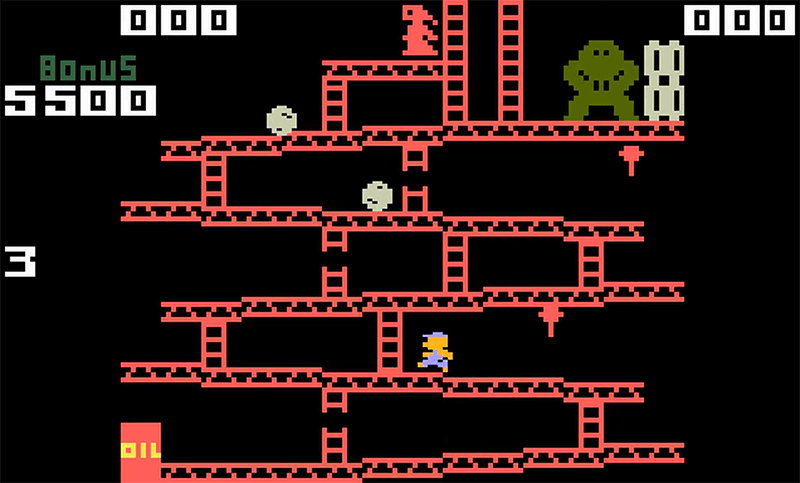
From everything discussed so far, as you can imagine, the Intellivision is a console of great interest to any collector of retro consoles. Intellivision is an indispensable piece to understand the history of video games at the end of the 70’s and 80’s, a super machine that was improved based on trial and error.
Like all second generation consoles, it is true that we will hardly be able to enjoy their video games during long gaming sessions, unless we are a few years old, have enjoyed that time and have the great power of nostalgia. But still, it’s a console more likely to be preserved than played.
Preserved and admired, since in addition to its controls and its games, if we get any of its multiple modules and peripherals we will witness cutting-edge technological advances from a bygone era. As retro collectors, the Intellivision universe is large enough to pose one of the most difficult challenges in our hobby, with almost impossible-to-find rarities like the Keyboard Component module.
If you are willing to start the adventure of collecting the Intellivision system, we wish you good luck, encouragement and patience, it is a system that deserves to be remembered and preserved. oh! Keep an eye on the North American market, that’s where the Intellivision enjoyed the most success.
Buy a second-hand Intellivision
Luckily for us, second generation consoles are mostly less sought after than third generation and up. The reason is simple, there are fewer console collectors who are old enough to be nostalgic for them, so we are less interested.
Thanks to this lower interest, those of us who are interested in preserving the history of retro consoles and video games, from their beginnings to the present, have the possibility of buying second-hand consoles like the Intellivision at a reasonable price, taking into account that we are talking of a console with more than 40 years and only 4 million units sold.
Next you have an ad that will take you to a list of the Intellivision that are being sold right now on eBay, with its updated price.
Yes, as you have seen Intellivision is a cheap console compared to most of the successful systems that followed. As always, if you only want to buy an Intellivision to play the original system, you will find it much cheaper loose than boxed, with manuals and so on, but in this case, even with the box it is a cheap console.
The only negative aspect is that since most of the units come from the United States, the shipping costs make the product more expensive, but even so, the price that we find on eBay is much more proportionate than on other sales platforms such as Wallapop, in which The sellers think they have a treasure on their hands…
Even though it is an economic system, as we always say, the best way to get a price within or below the market is to know the market itself, so we recommend you to be patient and enjoy hunting. Therefore, from the beginning, creating an Excel table with the market prices of the console, peripherals, and main games will help us in the search process.
Being a system with multiple versions and modules, below we share the links to eBay, with multiple searches in the most difficult to find modules:
| SHOP ON EBAY | |||||
| Keyboard Component | eBay | Intellivision Keyboard | eBay | Intellivision Computer | eBay |
| Intellivoice | eBay | Intellivision Voice | eBay | ||
| System Changer | eBay | ||||
| Entertainment Computer System | eBay | ECS Computer Module | eBay | ||
| Intellivision | eBay | ||||
| Super Video Arcade | eBay | ||||
| Intellivision II | eBay | ||||
| INTV SYSTEM III | eBay | ||||
| Intellivision Flashback | eBay |
STOP COLLECTOR! If you’ve seen the console listing on eBay, I want to say THANK YOU. Since 2004, the objective of Infoconsolas is to contribute to preserving the history of consoles and videogames through our own collection of systems and the hours of work invested in this very website.
Being an eBay partner listing, if you buy a game or console, you will be helping Infoconsolas in the preservation of video game culture, so thank you very much again!
TOP: Best Intellivision console games
For this occasion, we are going to share the video «Mattel Intellivision – UNBOXING and GAMES with Uncle Bruno», from the Hobby Consolas channel, in which, in addition to remembering the Mattel console by seeing it in operation, a review of the games is made most significant in the system. Huge Uncle Bruno, we hope you like it!

For those of you who have been left wanting more or are thinking of buying a couple of console cartridges, we leave you our particular Top of the best Intellivision games, a list of the most representative games of the system:
- Astrosmash
- Burgertime
- Pitfall
- Tron: Deadly Discs
- Shark! Shark!
- Zaxxon
- Donkey Kong
- Donkey Kong Jr.
- Pac-Man
- Defender
- Masters of the Universe: The Power of He-Man
- Galaxian
- Q*bert
- Tower of Doom
- Dig Dug
- Pole Position
- Utopia
- Bump ‘n’ Jump
- Frogger
FAQ Intellivision
Here you have the most frequent curiosities, questions and answers about the Mattel Intellivision console:
In September 1986 in the United States, June 1987 in Europe, October 1987 in Japan, and September 1989 in Brazil.
$275 in the United States.
132 video games until 1989.
Yes, the Intellivision II is a cheap version of the original console.
To the second generation of video game consoles.
Console cartridges and tapes with the corresponding peripherals.
Approximately 4 million worldwide.
Intelligent Television, intelligent television.
Spiker! Super Pro Volleyball, launched in 1989.
Yes, different tributes of different quality have been launched, both desktop consoles and controllers.
No, it was never officially launched, but it was planned and designed.
The Intellivision, without a doubt.
Intellivision technical characteristics
Here you have the technical characteristics of the Mattel Intellivision retro video game console, which coincide with the Sears Super Video Arcade, Intellivision II, INTV System III models:
- CPU: General Instrument CP1610 16-bit at 2 MHz.
- RAM: 1456 bytes (SRAM).
- ROM: 7168 bytes.
- Standard television interface chip(STIC): General Instrument AY-3-8900/AY-3-8900-1 at 4 MHz or 3.579545 MHz (NTSC).
- Resolution: 159 × 96.
- Colors: 16 color palette / 16 simultaneous colors on screen.
- Sound: General Instrument AY-3-8914 (AY-3-8914A/AY-3-8916 Intellivision II), 3 sound channels + 1 noise.
- Format: 4K, 6K, 8K, 12K, 16K or 24K cartridge + cassette (with expansion module).
- The cartridge input is used for expansion modules.
- 2 9-pin inputs for controls
- RF/RCA audio/video connector
Sources and external links
- Recursos de características técnicas basadas en la Wikipedia y manuales técnicos de Mattel.
- Recursos gráficos consolas:
- Folletos de Mattel Intellivision
- https://commons.wikimedia.org/wiki/User:Evan-Amos


